The 1932 Ford Roadster, a symbol of American automotive ingenuity, emerged during a time of economic hardship. The Great Depression had cast a shadow over the nation, impacting industries, including the automotive sector. Yet, amidst these challenges, the Ford Motor Company, under the leadership of Henry Ford, unveiled a vehicle that would become an enduring icon – the 1932 Ford Roadster.
This revolutionary roadster, with its sleek lines and innovative design, captivated the hearts of Americans, offering a glimmer of hope and a sense of freedom in a time of uncertainty.
The 1932 Ford Roadster was a departure from the previous model years, boasting a more streamlined and modern aesthetic. Its distinctive features included a rounded grille, teardrop-shaped headlights, and a graceful, sloping hood. The roadster’s lightweight construction and powerful engine, combined with its agile handling, made it a thrilling vehicle to drive.
The 1932 Ford Roadster was not just a means of transportation; it represented a spirit of optimism and a yearning for a brighter future.
Historical Context
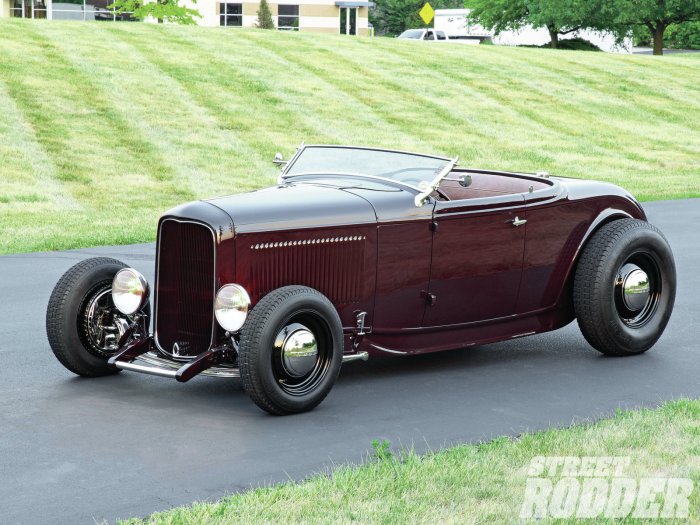
The 1932 Ford Roadster was born into a tumultuous era, shaped by the Great Depression, a period of economic hardship that profoundly impacted American society. Understanding the social and economic landscape of 1932 provides crucial context for appreciating the significance of this vehicle.
The Great Depression and its Impact on the United States
The Great Depression, which began in 1929, had a devastating effect on the United States. The stock market crash triggered a chain reaction of economic failures, leading to widespread unemployment, poverty, and social unrest. By 1932, unemployment had reached a staggering 25%, with millions of Americans struggling to make ends meet.
The depression significantly impacted all aspects of American life, including the automotive industry.
Impact of the Great Depression on the Automotive Industry
The Great Depression had a devastating impact on the automotive industry. The demand for new cars plummeted as consumers tightened their belts, leading to a sharp decline in production and sales. Many automakers faced financial difficulties, with some even going bankrupt.
The industry’s decline was exacerbated by the collapse of the credit market, making it difficult for consumers to obtain financing for car purchases.
Ford Motor Company during the Great Depression
Despite the challenges posed by the Great Depression, Ford Motor Company, under the leadership of Henry Ford, managed to survive. Ford implemented cost-cutting measures and streamlined production, focusing on producing affordable and reliable vehicles. The introduction of the Model A in 1927 had already positioned Ford to capitalize on the growing demand for affordable transportation.
While the company faced significant challenges, it continued to produce vehicles, providing jobs and contributing to the national economy.
Design and Features
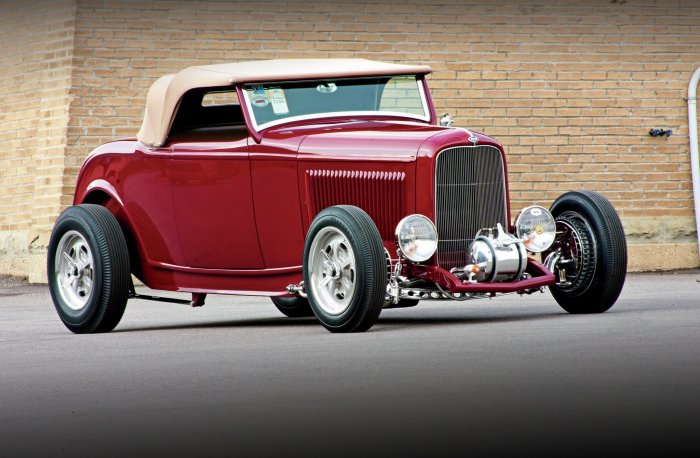
The 1932 Ford Roadster was a revolutionary design that defined the look of the American hot rod for generations to come. Its sleek lines, powerful engine, and innovative features made it a popular choice for both everyday driving and competitive racing.The 1932 Ford Roadster’s design was a departure from the more boxy and utilitarian cars of the time.
It featured a low-slung body, a long hood, and a short, raked windshield. The car’s overall profile was aerodynamic, which contributed to its performance and gave it a distinctive look.
Key Design Elements
The 1932 Ford Roadster’s design was characterized by several key elements:
- Steel Body:Unlike earlier Fords, the 1932 model featured an all-steel body, which was lighter and more durable than the wood-framed bodies of previous years.
- Integrated Running Boards:The car’s running boards were integrated into the bodywork, creating a smooth, streamlined profile.
- V-shaped Radiator:The distinctive V-shaped radiator grille was a hallmark of the 1932 Ford Roadster, and it became a popular design element for hot rods in the years that followed.
- Low-slung Body:The car’s low-slung body, with a height of just 54 inches, gave it a sporty and aggressive appearance.
Unique Features
The 1932 Ford Roadster also featured several unique features that set it apart from other cars of the time:
- Independent Front Suspension:The car’s independent front suspension system, a revolutionary feature for its time, provided a smoother ride and better handling.
- Three-speed Transmission:The 1932 Ford Roadster came standard with a three-speed manual transmission, which was sufficient for most driving conditions.
- Optional Four-wheel Brakes:While four-wheel brakes were not standard, they were an available option, offering improved stopping power.
- Optional Flathead V8 Engine:The 1932 Ford Roadster could be equipped with the optional Flathead V8 engine, which provided a significant power boost over the standard four-cylinder engine.
Comparison with Other Roadsters
The 1932 Ford Roadster was one of the most popular roadsters of its time, and it was often compared to other popular models, such as the:
- Chevrolet Roadster:The Chevrolet Roadster was a popular competitor to the Ford Roadster, offering a similar design and features. However, the Chevrolet Roadster was generally considered to be less refined and less powerful than the Ford.
- Dodge Roadster:The Dodge Roadster was another popular choice, but it was more expensive and less widely available than the Ford. The Dodge also had a less refined engine and a more utilitarian design.
- MG T-type:The MG T-type was a British roadster that was popular with enthusiasts. While it was more expensive than the Ford Roadster, it was also lighter, faster, and more nimble. The MG T-type was known for its sporty handling and its open-top design.
Performance and Handling: 1932 Ford Roadster
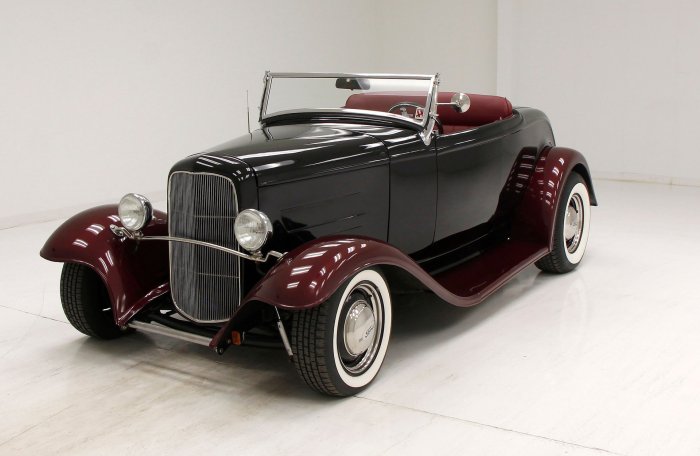
The 1932 Ford Roadster, despite its vintage, offered a driving experience that was both engaging and distinctive for its time. Its performance and handling characteristics were a product of the era’s automotive technology and design philosophy.
Engine Specifications and Performance
The 1932 Ford Roadster was powered by a 200 cubic inch (3.3-liter) inline four-cylinder engine. This engine, known as the “Flathead V8,” produced a modest 40 horsepower. This power output was sufficient for the roadster’s lightweight construction, providing a lively driving experience for its time.
The engine was paired with a three-speed manual transmission, which offered a simple and direct driving experience.
The 1932 Ford Roadster, a classic symbol of American automotive history, represents the era of streamlined design and powerful engines. While the Roadster embodied speed and elegance, the subsequent years saw a shift towards practicality and utility, exemplified by the 1947 Ford Pickup.
This workhorse pickup, with its sturdy build and reliable performance, became a mainstay in the post-war era, offering a stark contrast to the sleek Roadster. However, the enduring legacy of the 1932 Ford Roadster remains strong, inspiring enthusiasts and collectors alike with its timeless appeal.
Handling Characteristics
The 1932 Ford Roadster’s handling was characterized by its responsive steering and relatively nimble nature. The car’s open body design and lack of modern suspension components resulted in a more direct connection between the driver and the road. However, this also meant that the roadster could be susceptible to bumps and uneven road surfaces.
The lack of power steering and modern suspension technology contributed to a more physical and engaging driving experience.
Comparison to Modern Vehicles, 1932 Ford Roadster
Compared to modern vehicles, the 1932 Ford Roadster’s performance and handling would be considered significantly less powerful and less refined. Modern cars offer much higher horsepower outputs, advanced suspension systems, and a range of electronic driver aids that enhance safety and comfort.
However, the 1932 Ford Roadster’s simplicity and direct connection to the road provide a unique and engaging driving experience that is often appreciated by enthusiasts.
Cultural Significance
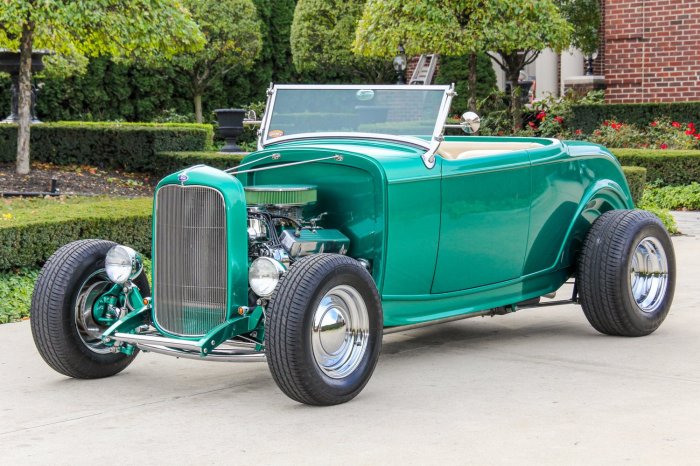
The 1932 Ford Roadster transcended its role as a mere vehicle; it became a symbol of an era, deeply embedded in the American cultural fabric. Its sleek design and affordability resonated with the aspirations of a nation emerging from the Great Depression, making it a coveted symbol of freedom, mobility, and the American dream.
Role in Popular Culture
The 1932 Ford Roadster’s impact extended beyond the automotive world, permeating popular culture and leaving an enduring legacy in films, music, and literature.
- Films:The 1932 Ford Roadster’s iconic status is evident in its frequent appearances in classic Hollywood films. Its sleek silhouette and undeniable charisma made it a natural choice for representing the spirit of the era. For example, the 1939 film “Gone with the Wind” features a 1932 Ford Roadster, emphasizing the vehicle’s association with the glamorous lifestyle of the time.
In the 1940s film noir classic “The Maltese Falcon,” the roadster served as a symbol of danger and intrigue, further solidifying its role in cinematic storytelling.
- Music:The 1932 Ford Roadster also found its way into the world of music. Songs like “Hot Rod Lincoln,” released in 1955, celebrate the thrill of driving a powerful roadster, further cementing its association with speed and freedom. The vehicle’s iconic status is also reflected in its frequent appearances in music videos, with artists like Bruce Springsteen and ZZ Top incorporating the 1932 Ford Roadster into their visual narratives.
- Literature:The 1932 Ford Roadster has also inspired authors, appearing in novels and short stories as a symbol of adventure, rebellion, and the open road. The vehicle’s association with freedom and the American spirit has made it a popular choice for authors seeking to evoke a sense of nostalgia or to create a sense of adventure in their narratives.
The 1932 Ford Roadster, a classic icon of the American automotive landscape, is often seen as a symbol of the roaring twenties. While it embodies a certain era, the legacy of Ford’s design extends beyond this period, as seen in the rugged 1961 Ford Pickup.
This truck, with its utilitarian design, speaks to a different aspect of Ford’s history, one rooted in work and practicality. However, both vehicles, despite their contrasting styles, represent the enduring spirit of innovation and engineering that has defined the Ford brand for generations.
Notable Owners and Enthusiasts
The 1932 Ford Roadster has attracted a diverse group of owners and enthusiasts throughout history, ranging from Hollywood celebrities to everyday car enthusiasts.
- Hollywood Celebrities:The 1932 Ford Roadster has been a favorite among Hollywood celebrities, with stars like Clark Gable, John Wayne, and Humphrey Bogart owning and driving these iconic vehicles. The roadster’s association with glamour and prestige made it a coveted possession for those seeking to project an image of success and sophistication.
- Hot Rod Enthusiasts:The 1932 Ford Roadster’s affordability and ease of customization have made it a popular choice among hot rod enthusiasts. These individuals have taken the classic roadster and modified it to create powerful and unique vehicles that reflect their personal style and passion for performance.
- Collectors:The 1932 Ford Roadster has become a highly sought-after collector’s item, with enthusiasts around the world vying to own and preserve these iconic vehicles. The roadster’s historical significance and enduring appeal have made it a valuable investment for collectors seeking to own a piece of automotive history.
Restoration and Preservation
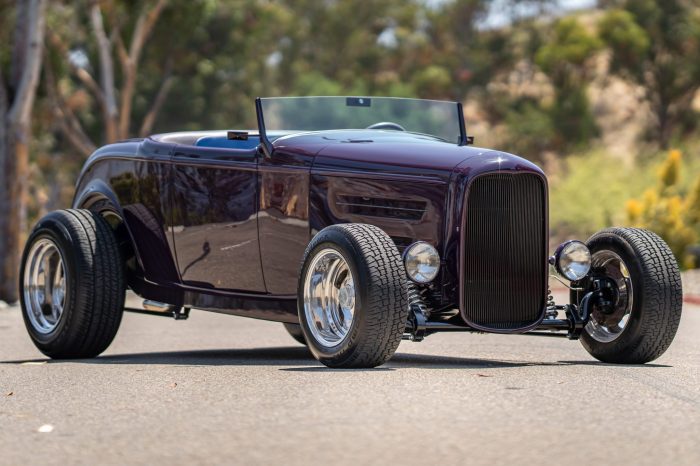
Restoring a 1932 Ford Roadster is a labor of love that involves meticulous attention to detail and a deep understanding of the car’s history. It’s a journey that challenges your skills, tests your patience, and ultimately rewards you with a piece of automotive history that you can truly call your own.
The 1932 Ford Roadster, a classic icon of the hot rod era, paved the way for a legacy of stylish and powerful vehicles. Ford continued to innovate, introducing the unique 1961 Ford Ranchero , a car that blended the practicality of a station wagon with the sporty appeal of a coupe.
Both the 1932 Roadster and the 1961 Ranchero represent Ford’s commitment to pushing boundaries and delivering vehicles that captured the spirit of their time.
Restoring a 1932 Ford Roadster
Restoring a classic car like the 1932 Ford Roadster requires a comprehensive approach that involves several key steps:
Disassembly and Inspection
The first step in the restoration process is to disassemble the car completely. This allows for a thorough inspection of every component, identifying areas that need repair or replacement. A detailed inspection helps determine the extent of the restoration project and the resources required.
Bodywork
The body of a 1932 Ford Roadster is often the most challenging aspect of the restoration. The original steel body may have rust, dents, or other damage that needs to be addressed. This involves removing rust, straightening dents, and preparing the body for paint.
Paint
After the bodywork is completed, the car needs to be painted. This requires careful preparation, including sanding, priming, and applying multiple coats of paint. A high-quality paint job can significantly enhance the car’s appearance and value.
Engine and Drivetrain
The engine and drivetrain of a 1932 Ford Roadster often require significant attention. This may involve rebuilding the engine, replacing worn parts, and ensuring the drivetrain is in good working order.
Interior
The interior of a 1932 Ford Roadster is a key element of its charm. Restoring the interior involves reupholstering the seats, replacing the carpets, and restoring or replacing the dashboard and other interior components.
Assembly and Testing
Once all the components have been restored, the car can be reassembled. This involves carefully fitting each part and ensuring everything functions correctly. The car is then tested to ensure it runs smoothly and meets all safety standards.
Challenges and Rewards of Restoring a Classic Car
Restoring a classic car is a challenging but rewarding experience. Here are some of the key challenges and rewards:
Challenges
- Finding parts: Original parts for classic cars can be difficult to find, and they can be expensive.
- Time commitment: Restoring a classic car is a time-consuming process that requires patience and dedication.
- Cost: Restoration can be expensive, especially if you need to replace many parts or hire professionals for specific tasks.
- Technical skills: Restoring a classic car requires a certain level of technical knowledge and skills.
Rewards
- Sense of accomplishment: Restoring a classic car gives you a sense of accomplishment and pride in your work.
- Unique vehicle: You’ll have a unique and valuable vehicle that stands out from the crowd.
- Historical connection: Restoring a classic car connects you to automotive history and allows you to appreciate the craftsmanship of a bygone era.
- Enjoyment: Owning and driving a restored classic car is an enjoyable experience that allows you to appreciate the beauty and performance of these iconic vehicles.
Resources and Information for Finding Parts and Services
Finding parts and services for restoring a 1932 Ford Roadster is easier than ever before, thanks to the internet and dedicated communities.
Online Resources
- eBay: eBay is a great source for finding parts for classic cars, including 1932 Ford Roadsters. You can find both new and used parts from sellers worldwide.
- Specialized websites: Several websites specialize in parts for classic cars, such as Classic Industries, and Mac’s Auto Parts. These websites offer a wide selection of parts, including both original and reproduction parts.
- Forums and communities: Online forums and communities dedicated to classic cars are excellent resources for finding parts, advice, and information on restoration.
Local Resources
- Classic car dealers: Classic car dealers often have parts and services available for restoration.
- Restoration shops: Restoration shops specialize in restoring classic cars and can provide a wide range of services, from bodywork to engine rebuilds.
Modern Interpretations
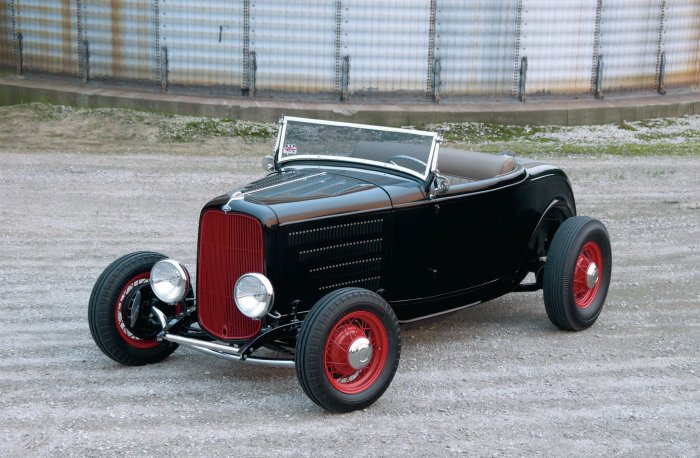
The 1932 Ford Roadster’s enduring appeal is evident in its lasting influence on contemporary car design. Its iconic silhouette, streamlined form, and timeless elegance have inspired countless modern vehicles, showcasing the enduring power of classic design.
Influence on Modern Car Design
The 1932 Ford Roadster’s influence on modern car design is multifaceted. Its streamlined bodywork, characterized by its low-slung profile and rounded curves, has been adopted by numerous contemporary vehicles, particularly in the realm of sports cars and luxury coupes. The roadster’s emphasis on simplicity and functionality, with its minimal ornamentation and focus on performance, has also resonated with modern designers, leading to the creation of sleek and aerodynamic vehicles that prioritize driving experience.
Contemporary Vehicles Inspired by the 1932 Ford Roadster
Several contemporary vehicles draw inspiration from the classic styling of the 1932 Ford Roadster. These vehicles often incorporate elements of the roadster’s design, such as its rounded fenders, sloping hood, and distinctive grille, into their own modern interpretations. Examples include:
- Ford Mustang:The Ford Mustang, a modern muscle car, pays homage to the 1932 Ford Roadster’s legacy with its long hood, sloping roofline, and distinctive grille. The Mustang’s design language, particularly in its early iterations, directly echoes the roadster’s streamlined aesthetic.
- Chevrolet Corvette:The Chevrolet Corvette, a legendary American sports car, has evolved over the years, but its early models, like the C1 and C2, were heavily inspired by the 1932 Ford Roadster’s design. These Corvettes featured a low-slung profile, rounded fenders, and a distinctive grille reminiscent of the roadster’s classic styling.
- Audi TT:The Audi TT, a modern coupe, incorporates elements of the 1932 Ford Roadster’s design, such as its rounded curves and low-slung profile. The TT’s distinctive grille and headlights also pay homage to the roadster’s classic styling, while its modern technology and performance capabilities showcase a contemporary interpretation of the roadster’s spirit.
Visual Comparison
A visual comparison between the 1932 Ford Roadster and modern interpretations reveals the enduring influence of its design. The roadster’s streamlined bodywork, characterized by its low-slung profile and rounded curves, is evident in the design of contemporary vehicles. [Visual comparison table with two columns: 1932 Ford Roadster and Modern Interpretations (e.g., Ford Mustang, Chevrolet Corvette, Audi TT)]
Final Summary
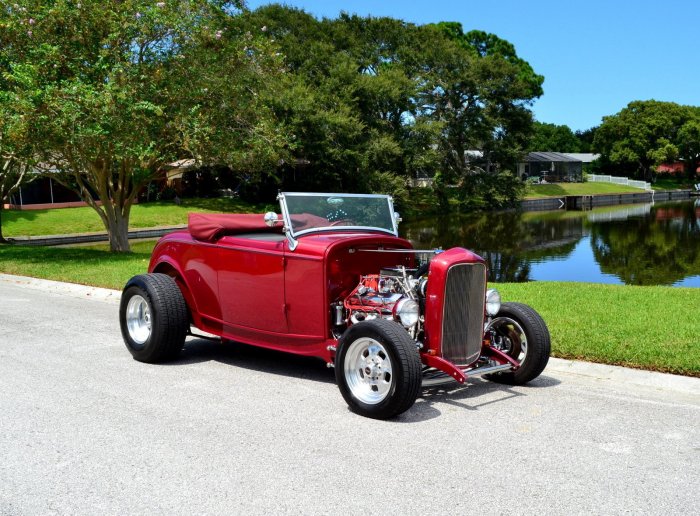
The 1932 Ford Roadster continues to capture the imagination of automotive enthusiasts today. Its timeless design, enduring performance, and cultural significance have solidified its place as a legend. Whether admired in museums, cruising down highways, or lovingly restored in garages, the 1932 Ford Roadster remains a testament to the ingenuity and craftsmanship of a bygone era.
Its legacy serves as a reminder of the enduring power of American automotive innovation and the enduring appeal of classic design.